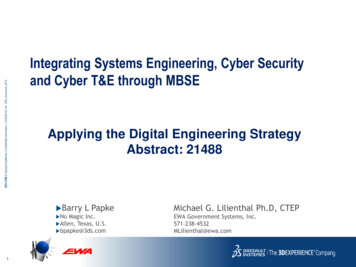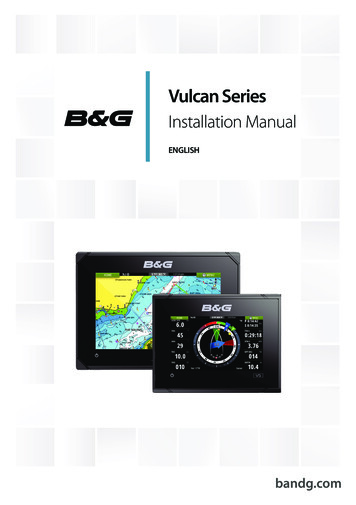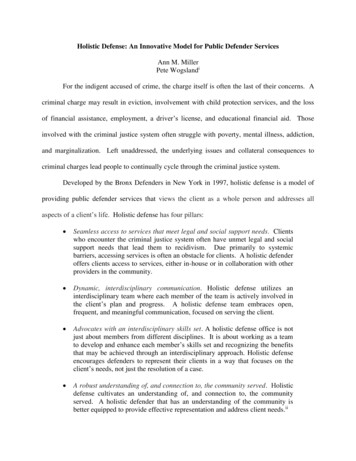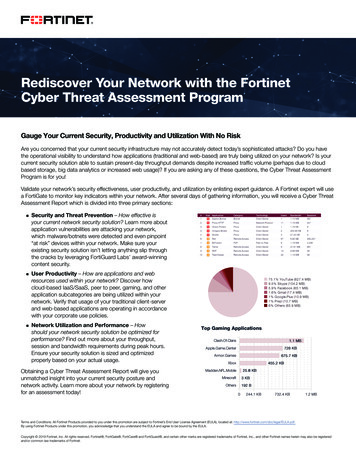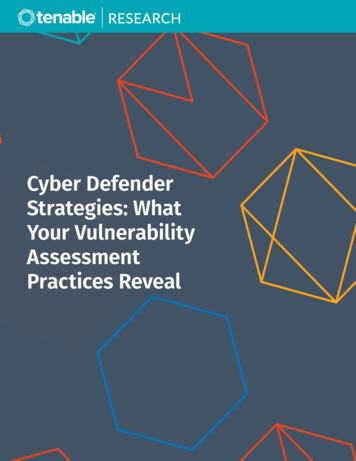
Transcription
Cyber DefenderStrategies: WhatYour VulnerabilityAssessmentPractices Reveal
CONTENTSExecutive erability Assessment Objectives5Vulnerability Assessment Key Performance Indicators and MaturityAnalysis710Vulnerability Assessment KPIs by Style11General VA Style Distribution12VA Style Distribution by Geography13Key Findings13VA Style Distribution by Employee Count14VA Style Distribution by Licensed Asset Count14VA Styles by Industry15Conclusion16Findings Summary17Recommendations for VA Maturity Levels18Appendix19Methodology 19Archetypal Analysis19References20Acronyms20Cyber Defender Strategies: What Your Vulnerability Assessment Practices Reveal2
I. EXECUTIVE SUMMARYIn this report we analyze real-world end-user vulnerability assessment (VA) behavior using a machine learning (ML)algorithm to identify four distinct strategies, or “styles.” These are based on five VA key performance indicators (KPIs)which correlate to VA maturity characteristics.This study specifically focuses on key performance indicators associated with the Discover and Assess stages of thefive-phase Cyber Exposure Lifecycle. During the first phase – Discover – assets are identified and mapped for visibilityacross any computing environment. The second phase – Assess – involves understanding the state of all assets,including vulnerabilities, misconfigurations, and other health indicators. While these are only two phases of a longerprocess, together they decisively determine the scope and pace of subsequent phases, such as prioritization andremediation.The actual behavior of each individual enterprise in the data set, in reality, exhibits a mixture of all VA Styles. For thepurposes of this work, enterprises are assigned to the specific style group with which they most closely align. Weprovide the global distribution of VA Styles, as well as a distribution across major industry verticals.FINDINGS Enterprises conducting VA fall into four distinct VA Styles, ordered by maturity: Diligent, Investigative,Surveying and Minimalist. The Diligent style represents the highest maturity, yet constitutes only five percent of allenterprises in the data set. The Investigative style represents a medium to high maturity, with 43 percent of enterprisesfollowing this style. The Surveying style, with a representation of 19 percent in the data set, corresponds to a low tomedium maturity. The Minimalist style represents the lowest maturity and constitutes 33 percent of all enterprisesin the data set. The hospitality, transportation, telecommunications, electronics and banking industries had thehighest proportion of the mature Diligent style. The utilities, healthcare, education and entertainment industries had the highest proportion of thelow-maturity Minimalist style. The utilities industry had the highest proportion of the low-maturity Minimalist style overall. The distribution of VA styles by geographical region shows no noteworthy variation.Cyber Defender Strategies: What Your Vulnerability Assessment Practices Reveal3
II. INTRODUCTIONRECOMMENDATIONSThe cybersecurity community is heavily focused on what attackersare doing. While threat intelligence and vulnerability research isinvaluable, it only represents one side of the equation. Far lessresearch has been dedicated to how defenders are responding. There is a wealth of qualitative data available on what end users aredoing, primarily derived from surveys. The reliability of survey datais dependent on the knowledge and honesty of participants. Resultscan be skewed by cognitive biases and lack of awareness. Whatsomeone believes they are doing is not always the same as what theyare actually doing, especially when practical realities come into play.Quantitative research based on end-user behavior and telemetrydata provides a more reliable basis for determining the true state ofgeneral VA maturity.In our last report, “Quantifying the Attacker’s First-Mover Advantage,”we discovered attackers generally have a median seven-day windowof opportunity during which they have a functional exploit availableto them, before defenders have even determined they are vulnerable.The resulting seven-day gap is directly related to how enterprises areconducting VA.In this study, we analyze real-world VA telemetry data to group endusers into segments and identify four distinct strategies, or “styles,”of VA. Further analysis focuses on the distribution of these four VAStyles across industries.To classify the VA Styles, we applied a machine learning algorithmcalled archetypal analysis (AA) to real-world scan telemetry datafrom more than 2,100 individual organizations in 66 countries and justover 300,000 scans during a three-month period from March to May2018. AA identifies a number of idealized/archetypal VA behaviorswithin this data set. Organizations are assigned to groups definedby the archetype they are most similar to. This does not mean eachorganization in a group behaves exactly like the archetype. Rather,it means that, of the four archetypes, they are most similar to thearchetype which defines that grouping. The scanning behavior stylesdescribed in this report are based on these four archetypes.Cyber Defender Strategies: What Your Vulnerability Assessment Practices RevealEvaluate your ownvulnerability assessmentmaturity based on ourfive critical VA KPIs:Scan Frequency, ScanIntensity, AuthenticationCoverage, Asset Coverageand VulnerabilityCoverage. Identify your currentVA Style and compareyourself to industrypeers. Follow therecommendations foryour style to determinethe KPIs you needto improve to moveyour maturity to thenext level.4
VULNERABILITY ASSESSMENT OBJECTIVESThis study specifically focuses on key performance indicators (KPIs) associated with the Discover and Assess stagesof the five-phase Cyber Exposure Lifecycle. During the first phase – Discover – assets are identified and mapped forvisibility across any computing environment. The second phase – Assess – involves understanding the state of allassets, including vulnerabilities, misconfigurations and other health indicators. While these are only two phases of alonger process, together they decisively determine the scope and pace of subsequent phases, such as prioritizationand remediation.DiscoverModel and analyze CyberExposure to make better businessand technology decisionsIdentify and map every asset forvisibility across any computingenvironmentAssessMeasurePrioritize which exposures to fix first,if at all, and apply the appropriateremediation techniqueFixITIoTOTCloudAnalyzeUnderstand the state of allassets, including vulnerabilities,misconfigurations and otherhealth indicatorsUnderstand exposures in context, toprioritize remediation based on assetcriticality, threat context andvulnerability severityFigure 1: Tenable’s Cyber Exposure LifecycleVulnerability Assessment has traditionally been conducted by deploying a “scanner” to assess assets remotely overthe network, interrogating any open ports and available services to see if they are vulnerable.To accommodate diverse and complex use cases, and to cover emerging technologies, Vulnerability Assessment hasexpanded beyond pure dynamic remote scanning. Modern VA supports conducting assessments using local agents,by passive network monitoring, and by integrating with diverse third-party technologies – such as enterprise mobilitymanagement suites (EMM), hypervisors and Infrastructure-as-a-Service (IaaS) platforms – to gather additional dataabout vulnerability and asset state.Authenticated scanning, where credentials are used to gain a more thorough and reliable view of an asset, has alsobecome a staple in the vulnerability manager’s toolbox. Additionally, modern VA solutions support the centralizedmanagement of a tiered and heterogeneous scanning architecture, permitting the scheduling of scans, distributionof larger assessments across a pool of scanners, and the creation and customization of use-case specific scanconfiguration profiles for individual asset groups, business units or threat scenarios.Cyber Defender Strategies: What Your Vulnerability Assessment Practices Reveal5
Together, these capabilities provide the technological foundation for VA, but it is how they are used that ultimatelydecides the effectiveness of VA. The general objectives of an effective Vulnerability Assessment process aresummarized below: Scan sufficiently to fulfill regulatory requirements. Scan as frequently as possible to minimize the length of time in which a critical vulnerability mayreside in your environment without your knowledge, and to obtain up-to-date benchmarking and riskscoring intelligence. Gain as much visibility of critical vulnerabilities on assets as possible, beginning with uncredentialedremote assessments, and increasingly progressing to using authentication or a local agent to gain asystem-side view as well. Assess as much of the infrastructure as possible, extending across all deployed assets, technologiesand applications, to reduce the available attack surface an adversary can target. Leverage customized scan templates to tailor assessments to specific asset groups, business unitsand use cases, to reduce scan overheads and false positives and to limit unnecessary complexity.In practice, many enterprises weigh each of these objectives differently and fulfill them to varying degrees.Technological debt, resource availability, risk appetite and business requirements are all major factorsinfluencing VA maturity.Measuring VA maturity is more art than science. There are many competing Information Security Managementframeworks and compliance regimes, each with its own views on maturity. Below for example is how Gartner definesVulnerability Assessment maturity in its Vulnerability Management Maturity Model1. Further on in this report, we willillustrate how the VA Styles align to Gartner’s model.LEVELREMEDIATIONMITIGATIONMETRICS AND REPORTSNo repeatable VA;rare ad hoc VA by aconsultantOccasional patching ofOS; default automaticpatching (if any); noapplication patching; nooverall remediation andmitigation planningNo mitigationNoneCompliance-mandatedremediation cycle;minimum automationAd hoc mitigationCompliance for external mpliance-mandatedand some risk-basedremediationNetwork mitigation viaNIPSs and firewallsCompliance reportingwith some remediationprogress reporting11VAGartner, A Guidance Framework for Developing and Implementing Vulnerability Management, Augusto Barros, Anton Chuvakin, 22 June 2017Cyber Defender Strategies: What Your Vulnerability Assessment Practices Reveal6
LEVEL45VAREMEDIATIONMITIGATIONMETRICS AND REPORTSA mix of authenticatedand unauthenticatedVA scanning; selectsystems’ SecureConfigurationAssessment (SCA)VA and remediationlogically connected;consensus remediationplanning for riskreduction; matureprocess for validationof fixesNetwork and endpointmitigation; carefulmitigation trackingCompliance reporting,progress reports andrisk-based reports;hotspot analysisComprehensive VA andSCA; authenticatedscanning and nearuniversal systemcoverage, includingemerging ITenvironmentsTight integration ofremediation, mitigationand monitoring;automated remediationand risk-basedprioritization;analytics-drivendecision making forremediation;automated validation ofremediation actionsRisk-driven mitigationthat is linked toremediation andsecurity monitoringRisk-based reporting,trending andmetrics; continuousimprovement based onthe measuresFigure 2: Gartner’s Vulnerability Assessment Maturity LevelsIII. VULNERABILITY ASSESSMENT KEY PERFORMANCE INDICATORS ANDMATURITYOur data model analyzes distinct vulnerability assessment performance indicators derived from VA behavioraltelemetry data. These KPIs correspond to VA maturity. The table below details the KPIs we chose to measure todetermine maturity:SCAN KPIScan FrequencyScan IntensityWHAT IT MEASURESScan Frequency measures how often an enterprise conducts assessments, based on the average length of timebetween days when a scan ran (scan day). A higher frequency means fewer days between assessments, andconsequently means critical vulnerabilities can be identified faster.Low Scans every week, every month, or even less oftenModerate Scans every three to seven daysHigh Scans more frequently than every three daysScan Intensity measures how many different scans are launched on a given scan day. A higher Scan Intensityindicates an organization is executing multiple scans, whether to distribute a large scan across multiplescanners, or because they are using differentiated and customized scan templates to cover different assetgroups, technology families, or use cases.Low One scan on a given scan dayModerate Between one and six scans on a given scan dayHigh More than six scans on a given scan dayCyber Defender Strategies: What Your Vulnerability Assessment Practices Reveal7
SCAN KPIAuthenticationCoverageAsset CoverageVulnerabilityCoverageWHAT IT MEASURESAuthentication Coverage (whether using credentials or local agents) is a measure of the assessment depth.Unauthenticated assessments only provide a very limited and partial view, and yield more false negatives thancredentialed scanning.Low Less than 30 percent of scans include authentication credentialsModerate 30 percent to 70 percent of scans include authentication credentialsHigh More than 70 percent of scans include authentication credentialsAsset Coverage measures the proportion of the licensed assets scanned in a 90-day period. Thisis an important metric, as a low asset coverage may not be intended, but rather a consequence ofmisconfiguration or network routing issues.Low Less than 30 percent of all licensed assets are assessed over a 90-day periodModerate 30 percent to 70 percent of assets are assessed over a 90-day periodHigh More than 70 percent of assets are assessed over a 90-day periodVulnerability Coverage measures the proportion of total vulnerability plugins used in a 90-day period.This indicates the overall comprehensiveness of assessments in covering diverse technologies andvulnerability families. While it seems counterintuitive, a very high vulnerability coverage does notnecessarily indicate a higher level of maturity. There are a variety of vulnerability detection pluginscovering everything from mainstream to exotic technologies, so an excessively high vulnerability coveragein conjunction with only a single recurring scan indicates assessment is being conducted indiscriminatelyand without any customization. A high maturity approach will utilize a broad mix of vulnerability pluginsto be able to cover all of the technologies an enterprise may have deployed. These technologies will beselected based on existing and specific asset demographics, and used in targeted scan profiles. Gratuitousvulnerability plugin selection adds overheads which reduce efficiency and affect scan duration, and canpotentially increase the rate of false positives while introducing unnecessary complexity.Targeted Less than 25 percent of all available vulnerability pluginsComprehensive 25 percent to 75 percent of all available vulnerability pluginsUntargeted More than 75 percent of all available vulnerability pluginsFigure 3: Scan Behavior KPIs used in the analysisCyber Defender Strategies: What Your Vulnerability Assessment Practices Reveal8
For reference, we approximate our VA Maturity KPIs to Gartner’s VA Maturity Model in the table ity(per day)AuthenticatedScanningAssetCoveragePlugin rivenunauthenticatedscanning for eModerateModerateModerateTargeted4A mix ofauthenticated andunauthenticatedVA scanning; selectsystems’ SCAHighHighHighHighComprehensive5ComprehensiveVA and SCA;authenticatedscanning and nearuniversal systemcoverage, includingemerging ITenvironments1Figure 4: VA Maturity KPIs and Gartner’s VM Maturity Model*Level 1 indicates no repeatable VA is being conducted, and is therefore not included in the above table.Cyber Defender Strategies: What Your Vulnerability Assessment Practices Reveal9
IV. ANALYSISOur analysis resulted in four distinct Vulnerability Assessment Styles, or strategies, described below:THE “MINIMALIST” STYLELOW MATURITYThe Minimalist executes bare minimum vulnerability assessments asrequired by compliance mandates. Scans every week, every month or even less often Executes a single scan at a time Authenticates little Partial asset coverage Leverages a single, comprehensive scan templateTHE “SURVEYING” STYLELOW TO MEDIUM MATURITYThe Surveyor conducts frequent broad-scope vulnerability assessments,but focuses primarily on remote vulnerabilities. Scans every three days or less Executes a single scan at a time Authenticates little High asset coverage Leverages a single, comprehensive scan templateTHE “INVESTIGATIVE” STYLEMEDIUM TO HIGH MATURITYThe Investigator executes vulnerability assessments with a high maturity,but only assesses selective assets. Scans weekly or less Executes distributed or use-case specific scans Authenticates every scan Partial asset coverage Leverages a variety of streamlined, targeted scan templatesTHE “DILIGENT” STYLEHIGH MATURITYThe Diligent conducts comprehensive vulnerability assessments, tailoringscans as required by use case, but only authenticates selectively. Scans every three days or less Executes many segmented or differentiated scans Authenticates selectively High asset coverage Leverages distinct scan templates for different use casesFigure 5: The Four VA StylesCyber Defender Strategies: What Your Vulnerability Assessment Practices Reveal10
The radar chart below shows where the four VA scanning behavior styles fall on the maturity scale for each of our fiveKPIs. The Minimalist style immediately sticks out, showing a low maturity level across all KPIs. The Diligent style is alsonoticeable, showing a high maturity across four out of five KPIs. The Investigative style shows a peak for AuthenticationCoverage, deviating from the moderate maturity displayed for the remaining KPIs. The Surveying style draws atrapezoid, displaying an uncharacteristic mix of low and high maturity in the KPIs.VULNERABILITY ASSESSMENT KPIs BY STYLEVulnerability Assessment KPI’s by StyleDilligentInvestigativeSurveyingMinimalistScan FrequencyHIGHMEDIUMVulnerability CoverageLOWScan IntensityAsset CoverageAuthentication CoverageFigure 6: VA KPIs by StyleCyber Defender Strategies: What Your Vulnerability Assessment Practices Reveal11
Our analysis indicates the reality of VA maturity is more nuanced than imagined by traditional frameworks. Theheatmap in Figure 7 shows maturity doesn’t improve linearly across the five KPIs measured.Figure 7: VA KPIs by Style HeatmapGENERAL VA STYLE DISTRIBUTIONThe chart below shows the general distribution of VA scanning styles across all enterprises included in the data re 8: Overall VA Style DistributionCyber Defender Strategies: What Your Vulnerability Assessment Practices Reveal12
VA STYLE DISTRIBUTION BYGEOGRAPHYWhen we broke down the style distributionbased on geographic regions, we weresurprised to see very little variationbetween the three regions. Our conclusionis that, due to shared supply chains, theeffects of globalization and the associatedinternational trade norms, standards andregulations – as well as the relativelyuniversal objectives of vulnerabilitymanagement – geographical variations areless pronounced than anecdotal evidencesuggests. We are planning future researchon whether the differences are morepronounced on a national basis.Regi
five-phase Cyber Exposure Lifecycle. During the first phase – Discover – assets are identified and mapped for visibility . Vulnerability Assessment matu

